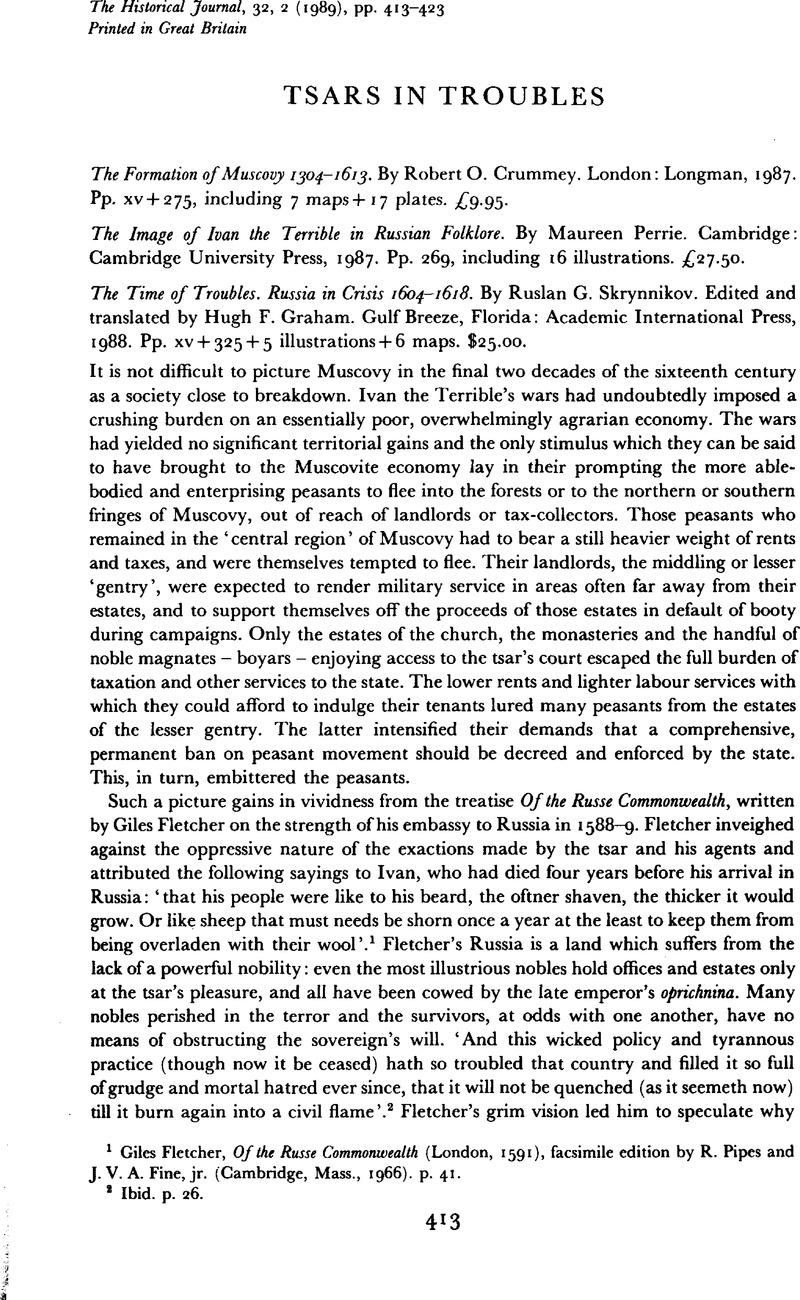No CrossRef data available.
Article contents
Tsars in Troubles
Published online by Cambridge University Press: 11 February 2009
Abstract

- Type
- Review Articles
- Information
- Copyright
- Copyright © Cambridge University Press 1989
References
1 Fletcher, Giles, Of the Russe Commonwealth (London, 1591)Google Scholar, facsimile edition by R. Pipes and J. V. A. Fine jr. (Cambridge, Mass., 1966). p. 41.
2 Ibid. p. 26.
3 Ibid. p. 34 verso.
4 Hellie, R., Slavery in Russia 1450–1725 (Chicago, 1982), p. 688Google Scholar.
5 Ibid. pp. 681–2, 468.
6 Cited in ibid. p. 575. The attribution to John Meyrick, an Englishman, is probable but not certain.
7 Perrie, , Image, p. 110Google Scholar.
8 Crummey, , Formation, p. 101Google Scholar.
9 Ibid. p. 167.
10 Ibid. p. 172.
11 Platonov, S. F., The Time of Troubles, trs. Alexander, John T. (Lawrence, Kansas, 1985)Google Scholar; Skrynnikov, Ruslan G., Boris Godunov, trs. Graham, Hugh F. (Gulf Breeze, Florida, 1982)Google Scholar; idem, Minin i Pozharsky (Moscow, 1981); idem, Sotsialno-politicheskaya borba v russkom gosudarstve v nachale XVII veka (Leningrad, 1985).
12 Crummey, , Formation, p. 226Google Scholar.
13 Though in 1606 Basil Shuitsky's boyar colleagues showed interest in the idea that the realm should be carved up into principalities: Skrynnikov, , Troubles, p. 43Google Scholar.
14 Ibid. p. 119.
15 Crummey, , Formation, p. 140Google Scholar.
16 Skrynnikov, , Troubles, p. viiGoogle Scholar.
17 Ibid. p. 160.
l8 Ibid. pp. 252–3.
19 Ibid. p. 50.
20 Ibid. p. 52.
21 Ibid. p. 55. A fortnight later, Istoma Pashkov and his military servicemen likewise deserted.
22 Ibid. pp. 268–70.
23 Ibid. p. 209.
24 Ibid. pp. 276–7. The Romanovs' tale is reminiscent of claims by post-Conquest Norman writers that Edward the Confessor had formally appointed William of Normandy as his heir: Barlow, F., Edward the Confessor (London, 1970), pp. 107–8Google Scholar.
25 Perrie, , Image, pp. 86–7Google Scholar.
26 Fletcher, , Commonwealth, p. 42Google Scholar.
27 Perrie, , Image, p. 105Google Scholar.
28 The appearance in Russian historical writing around 1600 of portrayals of tsars as complex characters, mixtures of good and evil, is discussed by Børtnes, J., Visions of glory. Studies in early Russian hagiography (Oslo, 1988), pp. 206–9Google Scholar.
29 Perrie, , Image, pp. 111–12Google Scholar.
30 Ibid. pp. 238–9; cf. 48, 50.
31 Ibid. p. 65.
32 Ibid. pp. 162–5.


